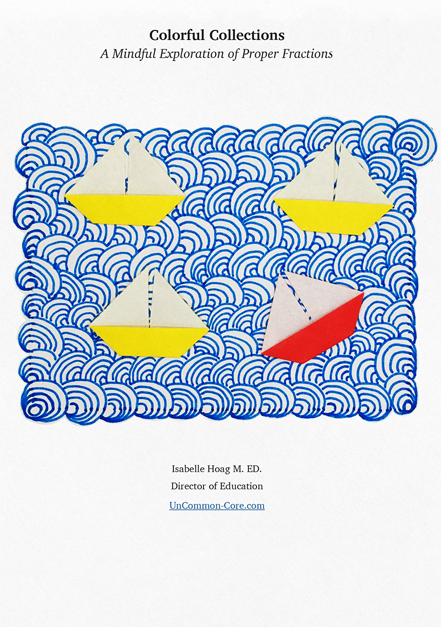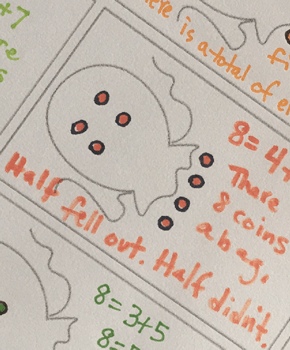
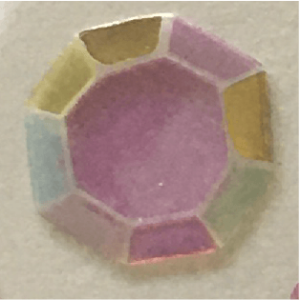 Immersive & fun, math centered games provide students with whimsical contexts in which to practice math skills. It is well known that pirates love to count their pieces of eight, royal children spend copious amounts of time designing crowns, and dragons keep their treasures well polished.
Immersive & fun, math centered games provide students with whimsical contexts in which to practice math skills. It is well known that pirates love to count their pieces of eight, royal children spend copious amounts of time designing crowns, and dragons keep their treasures well polished.
Play Provides an Authentic Context for Math Practice
Many teachers strive to provide authentic settings in which their students practice math skills.
Context helps students imagine circumstances which require logical thinking and mathematical reasoning. It gives students a reason to practice calculations and a big picture rationale for spending time and energy to become proficient in the skills they are learning. Contextualizing math problems encourages youngsters to make deep personal connections with an academic subject which can be intimidating to many students.
Let’s step back and take a look at authentic contexts for doing math. What does authentic mean? To us? to kids? Well, motivating, engaging, availability of rich connections with personal life and other academic topics, provides rationale for practicing the targeted skill, includes opportunities to use mathematical vocabulary and reasoning, could also include rationale for using written work, familiar to children; comfortable but interesting, mimics real world experiences.
What are some settings which would give children authentic reasons to do math? Shopping, cooking, sewing, crafting, paper folding, birdhouse building, party planning, parsing poetry, pattern exploration, building with blocks, quilting, drawing what you quilted or built from blocks, square dancing, line dancing, planning and creating Rube Goldberg machines, collecting and sharing data from science experiments, and so on. Would you include games? Monopoly? Yahtzee? Cribbage?
What are some authentic contexts that would not work for students? Being able to fill out tax forms when they grow up? You need to know this for the test? No matter how authentic these settings may be, young students will not find them very engaging.
There are many times when ‘participating in math class’ is going to be the context of a math lesson. In order to make ‘participating in math class’ an authentic and engaging context, we may think of it as ‘doing what mathematicians do’ or ‘thinking like mathematicians’ or even ‘ passing down the secrets of the ages.’ We make use of biographies and stories to illuminate the people behind the calculations, put the story in history – explain how young Gauss calculated faster than his teacher could imagine was possible, or how Fibonacci was misunderstood when he first tried to bring Arabic numerals into thirteenth century Italy. These realistic contexts are exciting for building logical thinking, direct teaching of math skills and concepts, and reflecting on, solidifying , or verbalizing mathematical understandings.
What about when we want to provide our students with opportunities for mindful application of what they are learning? When we want to give them a reason for practicing their new ideas? What about the ‘you do’ part of gradual release of responsibility?
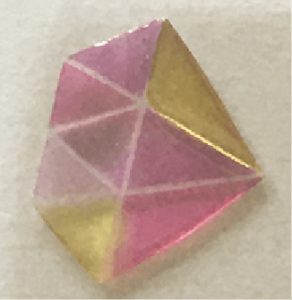 If teachers think of ‘authentic’ only as ‘real life’ we might be missing out on engaging – yet fanciful – opportunities that provide genuine rationales for kids to get excited about math. Children have wild imaginations, they are steeped in fairy tales, cartoon lands with cartoon characters, they love to pretend, they love to play. So how can we use this personal excitement in math class?
If teachers think of ‘authentic’ only as ‘real life’ we might be missing out on engaging – yet fanciful – opportunities that provide genuine rationales for kids to get excited about math. Children have wild imaginations, they are steeped in fairy tales, cartoon lands with cartoon characters, they love to pretend, they love to play. So how can we use this personal excitement in math class?
Princess, Pirate, Dragon, Prince
These games started as ways to help young students conceptualize decomposing numbers. They set the scene to provide students with lots of repeated practice. Feel free to experiment with different ideas in order to adapt these games to fit the needs of your students. Introduce Princess, Pirate, Dragon, Prince to your students during math group time. Once they understand how to play, you might consider having pairs of students play during free time.
Pirate! Pieces of Eight
Pirate booty is kept safe in soft, drawstring bags. Each bag holds eight coins, no more, no less. Unfortunately, it is very difficult for pirates to handle bags of coins on the high seas when each wave rocks their ship. Every time coins slip out the pirates must make sure none have been lost.
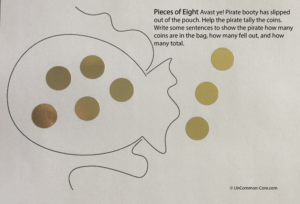 Pirate! Pieces of Eight focuses exclusively on decomposing and recomposing the number eight. In depth practice with eight will give your students confidence while they become familiar with the process and the thinking required to decompose numbers. Your students’ expertise in finding number pairs that add up to eight will transfer to other numbers, too.
Pirate! Pieces of Eight focuses exclusively on decomposing and recomposing the number eight. In depth practice with eight will give your students confidence while they become familiar with the process and the thinking required to decompose numbers. Your students’ expertise in finding number pairs that add up to eight will transfer to other numbers, too.
Academic standards and learning goals: Bring academic standards into the math lesson as usual. If you are following this example, identify the standards used by your school or district concerning decomposing numbers. Write learning goals according to the format used in your school. For example: “I can find all the number bonds for 8,” or “I can combine two numbers to make 8,” or even, “I can decompose the number 8.” Use academic vocabulary recommended by your school and familiar to your students. Post and share the learning goals for the lesson.
Materials: Pieces of Eight can be played with only your imagination, a pirate accent, and stuff you already have in your classroom. If you want your students to keep a written record of their work, you will need paper and pencils. Find some ‘treasures’ to count; pebbles, coins, or paper clips, and a bag to hold them. Help your crew set the scene by donning imaginary swashbuckler hats, plumes, extremely quiet shoulder parrots, and perhaps sing a whispered sea chanty or two. It is the perfect day to wear gold hoop earrings and striped pants.
If you want to collect a few props, here are some items to look out for: treasures to count such as pieces of eight, a velvet bag, drawstring pouch, or treasure holder of some sort. You might want to get some simple costumes such as eye patches flipped up, of course, so that savvy pirates can see out of both eyes. Be mindful of how these will be shared or cleaned. If your students enjoy this game you may want to invest in a class set which can be sent home with a bag of treasure at the end of the year. Send a wish list to caregivers after Halloween just in case families have any leftover pirate gear.
Prepare at least one bag of eight coins to use in your math group. Make the task easier by starting out with a transparent bag or plastic baggie.This allows everyone to see the amount left inside after the pirate ‘spills’ the coins onto the table. You might also consider finding some gold half inch circular stickers to use at the end of the lesson with the pirate pouch printable handout.
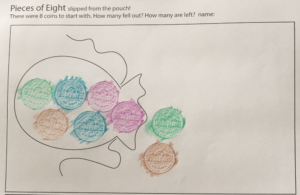 Print and copy Pieces of Eight handouts for your crew. You could make two sided copies on regular printer paper or make single sided copies on cardstock. Single sided copies on stiff paper could be used to collect and display all possible number bonds that add up to eight. Students could sort their ‘cards’ into various arrangements to help them make sure they have a complete set.
Print and copy Pieces of Eight handouts for your crew. You could make two sided copies on regular printer paper or make single sided copies on cardstock. Single sided copies on stiff paper could be used to collect and display all possible number bonds that add up to eight. Students could sort their ‘cards’ into various arrangements to help them make sure they have a complete set.
Have crayons, markers, pencils, and gold stickers at the ready. If you have some actual pirate coins handy, then you could use them to make rubbings onto the Pieces of Eight handout instead of using stickers or drawings. Of course some pennies or dimes would do just as well, plus connect the activity with counting money.
PLAY
It was a dark and stormy night . . . Gather your math group as usual, with bag in hand, lean in, speaking in a conspiratorial pirate whisper. “Avast, me hearties! I be yer pirate captain.” Of course the teacher is always the captain. “I have invited you to my cabin so we can count our pirate treasure in private – away from prying eyes if you get my drift. This bag has eight coins inside. Oh! Our ship is rocking gently on the waves today.” Sway gently from side to side, let your crew sway gently, too. “I hope no coins spill out of this bag. Arrrg!” Let seven coins fall from the bag. “Look sharp. How many coins have fallen out?” Let a crew member count. Let the others show if they agree or not. “Thumbs up for ‘yes,’ down for ‘no,’ in the middle for ‘I don’t know.’ Ah – seven coins fell out!”
Demonstrate how you want students to keep track of various ways to decompose eight by marking your demonstration paper/display. Or save this for later in the lesson. Make a ‘pirate thinking’ face. Keep swaying with the waves if you want to or gradually stop – captain’s choice. “Hmmmmm. So, we started with eight pirate coins in the bag, seven fell out, show on your fingers how many are left in the bag.” At this point you could even have each crew member feel the single coin left in the bag or verify that there is only one if needed. Show them how to mark that on their papers. “Now, I’ll put the other coins back inside. Let’s count, starting with the one in the bag.” Put your hand on the bag and say, “one,” then continue counting as you slowly drop coins back into the bag. “Eight! Yo ho ho!”
Let a different number of coins ‘accidentally’ slip out. “Argg! We have to make sure all eight coins are present and accounted for! ”
Prompt your math group to calculate the number of coins left in the bag, write the number bond on their sheets using the correct format and then – saying the number in the bag first – count the ‘spilled’ coins back into the bag. Give students time to draw the bag and any coins spilled out on the table. Next to the picture, have your students write both number sentences and English sentences. This will help students conceptualise the connections between the images, language, and math.
Practice: At this point, you might want to have your math group continue working together or in pairs in order to benefit from the support of a peer as they investigate number bonds. Eventually, when they understand what to do, and are more confident, send them back to their desks with the Pieces of Eight handout and instructions on how to complete it. Possibilities include making rubbings of one coin eight times, using stickers, or having students draw in the coins.
More! Extensions and Alternatives
After writing down all the pairs of numbers that make eight, your crew could use the same story and materials to show how three or more numbers can be combined to make eight. This is easy to do by having the coins slip out of the bag and land in two groups.
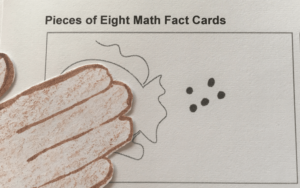 What if it turns out that there are pirates in the distant seas who keep different amounts of coins in their swag bags!?! Let your students use the story and materials to decompose numbers other than eight. You may want to set up a display of all the number bonds discovered by your math crew.
What if it turns out that there are pirates in the distant seas who keep different amounts of coins in their swag bags!?! Let your students use the story and materials to decompose numbers other than eight. You may want to set up a display of all the number bonds discovered by your math crew.
Pirates! Pieces of Eight can be used to practice “counting on” by having only one, two, or three coins fall from the bag. Place hands on the bag and say the number inside, then count on to make sure there are still eight coins. To get students out of the habit of counting the coins inside the bag, have them write the number on the bag rather than drawing the coins.
If you had your students create a complete set of Piece of Eight math fact cards, kids can use them to review their math facts. This time, instead of drawing the coins that didn’t fall out, have your students leave the bag blank. Then, based on the number of coins that fell out and knowing that there are always eight coins in a bag, your students can calculate the missing number.
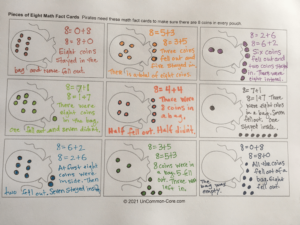 Bring back the pirate theme when your class studies fractions. Practice the same game except this time have your students explain the answers in fractions of eight. Again have them draw pictures and write sentences to explain their answers.
Bring back the pirate theme when your class studies fractions. Practice the same game except this time have your students explain the answers in fractions of eight. Again have them draw pictures and write sentences to explain their answers.
Bring fiction and nonfiction stories and texts into your class so students can study up on pirate lore. They may like to learn about the history of real pieces of eight, or write their own pirate adventures.
Ten Gems
Do your students have to help around the house? What kinds of chores do they do at home? At school? Do princesses and princes have to help around the house – erm – castle, too? Of course.
In addition to shooing peacocks from the royal gardens or collecting rose petal treats for their pet unicorns, princesses and princes are required to design their own crowns. Unfortunately, they are frequently interrupted during this task. They draw pictures and make notes of the situation in order to remind them what they were working on before they had to leave.
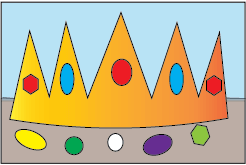 The Ten Gems game gives your students practice finding and sorting number bonds that add up to ten. Conceptualizing ten as pairs of numbers is extremely useful for math students. We use a positional number system made up of ten digits, 0, 1, 2, 3, 4, 5, 6, 7, 8, 9, so that each place in a number denotes a different power of 10. The proportions between the value of each place vary by magnitudes of ten. For example, one thousand is ten times more than one hundred. Knowing how to decompose ten is an essential understanding when using our base ten number system.
The Ten Gems game gives your students practice finding and sorting number bonds that add up to ten. Conceptualizing ten as pairs of numbers is extremely useful for math students. We use a positional number system made up of ten digits, 0, 1, 2, 3, 4, 5, 6, 7, 8, 9, so that each place in a number denotes a different power of 10. The proportions between the value of each place vary by magnitudes of ten. For example, one thousand is ten times more than one hundred. Knowing how to decompose ten is an essential understanding when using our base ten number system.
Academic standards and learning goals: will be similar to those used when playing Pirate! Pieces of Eight. Additional standards and goals relating to place value and number systems might also apply depending on how you teach the game.
Materials for Ten Gems may include some sort of crown, jewels or jewel like alternatives, math journals if you use them, and copies of Ten Gems handouts for your students to use independently. Students may also need sparkle glue, paste, markers, pens, pencils and rulers.
Young royals in your class might enjoy the opportunity to make their own crowns. As long as wearing a ‘thinking crown’ helps princes and princesses focus on their work, they can be used in class. Otherwise, crowns could be sent back to the castle to be worn during homework. These easy crowns are made from many 3 x 3 squares of paper, glue, and ten gems. You may want to use squares that are the right size so that your students’ crowns have ten spikes each.
As the Jeweler to the Royal Family, you may want to place the demonstration crown upon a vermillion velvet pillow after it has been decorated. Of course, it would be a terrible thing if any of the priceless jewels were to fall off! Young royals might be required to document how many of the ten original jewels fell off and how many stayed on before they repair the crown. Hopefully, they won’t get interrupted whilst in the process of repairing the crown.
PLAY!
Once upon a time, in a castle not too far from here . . .
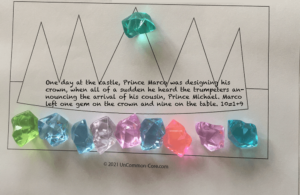 “Good morning, my lords and ladies. Today we are going to decorate our royal crowns. Hopefully, we will complete this task before you are called away to do your chores. When complete, each crown will display ten exquisite gems from the royal vault. We cannot attach the gems until we have created a beautiful design.” Count the gems to make sure there are exactly ten. Carefully arrange a few on the flattened out crown leaving the rest on the table nearby.
“Good morning, my lords and ladies. Today we are going to decorate our royal crowns. Hopefully, we will complete this task before you are called away to do your chores. When complete, each crown will display ten exquisite gems from the royal vault. We cannot attach the gems until we have created a beautiful design.” Count the gems to make sure there are exactly ten. Carefully arrange a few on the flattened out crown leaving the rest on the table nearby.
No sooner have you started, than you receive a message – perhaps a note upon a silver salver – requesting the pleasure of the presence of the young royals in the greenhouse in order to gild some lilies. “Alas, alack, I trow that you don’t want to lose your place while gilding lilies. Let’s write sentences to show the total number of gems as well as how many gems have been placed on the crown & how many have not.” Have students draw a 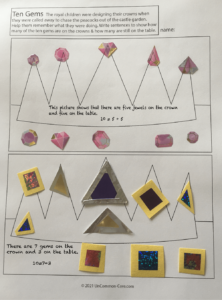 quick sketch showing gems on the crown and others on the table. Then, they can write sentences and sentences in order to understand that the image, number sentence, and English words are all describing the same mathematical idea.
quick sketch showing gems on the crown and others on the table. Then, they can write sentences and sentences in order to understand that the image, number sentence, and English words are all describing the same mathematical idea.
Have students pretend to paint some lilies with liquid gold, then “return” to the crown decoration process. “Ye, verily, I hope that was the final interruption to occur in the middle of your designs.”
Demonstrate how to play Ten Gems properly. Make sure everyone in the math group understands what to do and how you want them to record the number bonds as they decompose ten. Play a few extra rounds as a group to ensure that everyone is confident. Gradually release control of the game to your students.
Prompt them as needed if they forget a step or have a question. Let them continue in pairs or small groups. Follow steps for gradual release of responsibility as you and your royals play.
When the students are ready for independent practice, give them copies of the Ten Gems handout and any materials they may need. Encourage them to find all the pairs of numbers that add up to ten. They may want to arrange their work in order to make sure they have illustrated every possible pair of numbers that add up to ten.
Regal Alternatives and Extensions
Bring reading and writing into the Ten Gem game. Royal youngsters are frequently interrupted as they use ten gems to decorate their crowns. Some of your students may want to create a chore list for the royals listing all the chores that princes or princesses are required to do around the castle. Use this list as excuses when the royals get called away in the middle of their design work. Also, be sure to have lots of fiction and nonfiction books about royals, castles, knights, and chivalry in your class library for students to enjoy with or without their thinking crowns. Include stories and information about royalty from many different cultures.
Ten Gems can be adapted to practice counting on, visualizing fractions, or decomposing ten into groups of three or more. Ten is an important concept in our place value system which makes it important to spend time finding all the number bonds for ten. You might also adapt this game to help your students understand decimals or switch between fractions & decimals.
What if royals in far off realms decorate their crowns with numbers other than ten?!?! Well, then use the same game and handouts to decompose those numbers, too.
Dragon’s Dozens
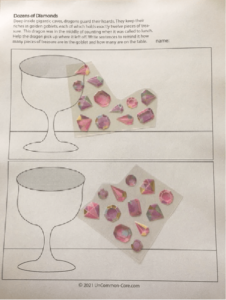 Dragons are well known for hoarding treasure. Normally, they store their diamonds in groups of twelve hidden in various containers such as golden goblets. Like pirates, dragons are prone to spilling diamonds from the goblets due to the difficulty of holding on to delicate things with all those claws. Like royals, dragons are extremely busy and often get called away in the middle of polishing their gems. Help the dragons see that even though some gems are on the table and some are inside the golden goblet, there are still twelve in total.
Dragons are well known for hoarding treasure. Normally, they store their diamonds in groups of twelve hidden in various containers such as golden goblets. Like pirates, dragons are prone to spilling diamonds from the goblets due to the difficulty of holding on to delicate things with all those claws. Like royals, dragons are extremely busy and often get called away in the middle of polishing their gems. Help the dragons see that even though some gems are on the table and some are inside the golden goblet, there are still twelve in total.
Dragon’s Dozens sets the stage for decomposing the number twelve. Your students will benefit from cataloging every pair of numbers that adds up to twelve. They will be able to apply the skills gained and the reasoning used in the process of playing the Dragon’s Dozens game to solve new problems.
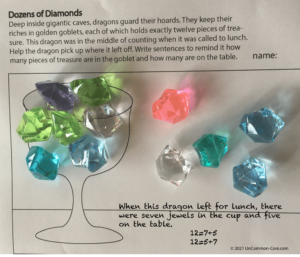 Academic standards and learning goals are similar to those used in Pirates! Pieces of Eight and Ten Gems. Variations of Dragon’s Dozens easily encompass math concepts such as multiplication/division, fractions, proportional thinking and geometry. Prepare learning goals according to your school or district conventions. Post learning goals where everyone can see them and refer to them during lessons.
Academic standards and learning goals are similar to those used in Pirates! Pieces of Eight and Ten Gems. Variations of Dragon’s Dozens easily encompass math concepts such as multiplication/division, fractions, proportional thinking and geometry. Prepare learning goals according to your school or district conventions. Post learning goals where everyone can see them and refer to them during lessons.
Materials: You have everything needed to play Dragon’s Dozens already in your classroom: pencils, paper, things to count, and imagination.
Dozens of Dragons can also be played using a golden goblet, acrylic diamonds (not safe for young children or some special needs students), scales (bucket balance not dragon), and treasure such as antique keys, rings, or anything that is shiny or makes a satisfying clink when tossed together. You may crave an entire set of dragon’s claws but really, each dragon only needs one for counting.
Prepare copies of the Dragon’s Dozens handout along with materials such as scissors, glitter glue, and paste. In place of actual diamonds, consider using stickers, or metallic tape cut to look like expensive gemstones.
Dozens of Alternatives and Extensions
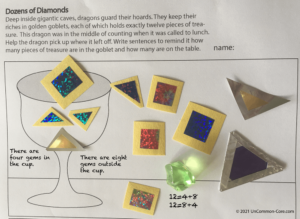 Students love to read and write about dragons. Academic connections to the Dragon’s Dozens game could include learning about maps, dinosaurs, or reptiles. Fill your class library with fables, fairy tales, and legends about dragons (close cousins of bookwyrms). Let some of these stories be written and illustrated by the young authors in your class.
Students love to read and write about dragons. Academic connections to the Dragon’s Dozens game could include learning about maps, dinosaurs, or reptiles. Fill your class library with fables, fairy tales, and legends about dragons (close cousins of bookwyrms). Let some of these stories be written and illustrated by the young authors in your class.
Jewels come in all sizes and shapes. Students can make their own treasure hoard and learn about geometry. Gems can be folded from origami paper. Another way to create your own treasure trove is to snip geometric shapes out of metallic or iridescent tape and stick them to construction paper.
Adapt Dragon’s Dozens to give students practice with multiplication facts with 12 as the product. Let your students explore fractions with 12 in the denominator. Have them think about probabilities when tossing twelve sided dodecahedral dice.
Dragons are always polishing and weighing out their treasure troves. This might be a good time to talk about weights and measures, leverage the connections between science and math, and provide context for learning how to weigh things accurately. Accuracy is important to dragons.
Finally, set your mages and dragons the task of looking for patterns when decomposing numbers. For example, challenge them to compare the number of math facts that can be made with two addends and the sum. Let them write a proclamation to share their findings.
| Number Facts (for pairs of addends) | Number of facts | Sum |
| 1+ 0, 0+ 1 | 2 | 1 |
| 2 + 0, 0 + 2, 1 + 1 | 3 | 2 |
| 3 + 0, 0 + 3, 1 + 2, 2 + 1 | 4 | 3 |
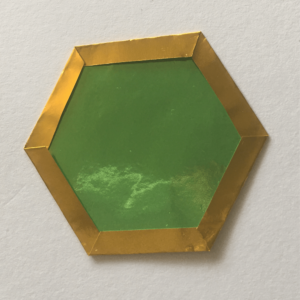
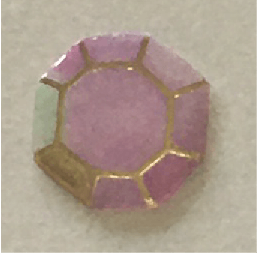
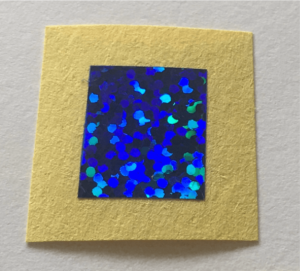
Authentic contexts where students can apply new ideas as well as practice math skills help children stay focused & engaged. They set the stage for children to work. They encourage students to make connections between math and other areas of the curriculum. Authentic doesn’t have to mean ‘real life.’ Children are always ready to play pretend. A pirate’s need to count pieces of eight is just as relatable and authentic for children as making change when shopping. Princess, Pirate, Dragon, Prince is a series of engaging math activities that seem like child’s play and yet deliver authentic, and fictional, contexts for learning math.
Share This Story, Choose Your Platform!
Download Colorful Collections:
A Mindful Exploration of Proper Fractions
Help your students make sense of fractions.
I started teaching in 1987, which means I’ve collected many tips and tricks along the way. In this ebook, I share concepts, strategies, and classroom materials to help you make math sticky.
Along with this useful ebook, you will receive weekly emails from StickyMath@UnCommon-Core.com. I send information like: teacher tips, educational ideas, book reviews, curated lists, reviews of educational sites, and free first drafts of products that I’m creating for my TPT store. That way, you get helpful ideas and free stuff, while I get some feedback before I finalize products and put them up for sale.
I value your privacy. I will never sell your information. You may unsubscribe at any time.
All the best!
Isabelle
Isabelle Hoag M. Ed.
